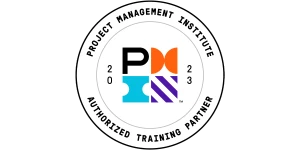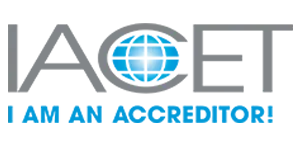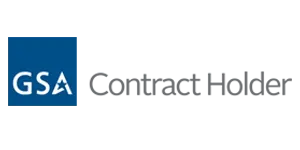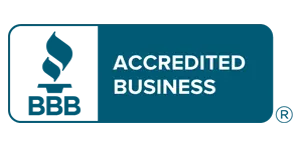The 7 Core Competencies of SAFe: A Comprehensive Guide to Business Agility
Market conditions shift overnight and customer expectations grow rapidly. Competitors emerge from unexpected quarters.
The ability to respond quickly to these changes isn’t just advantageous—it’s essential for survival.
This is where business agility becomes critical. But achieving true agility at scale remains elusive for many enterprises.
Learn how to recognize and eliminate process wastes
Transform your organization’s approach to value delivery with Lean Fundamentals.
The Scaled Agile Framework (SAFe) emerged as a response to this challenge. Since its introduction in 2011, SAFe has evolved through multiple versions, with each iteration refining its approach to enterprise agility.
The framework draws heavily from lean fundamentals, incorporating principles like value stream mapping, flow optimization, and waste reduction.
SAFe 6.0 have seven distinct competencies that organizations must develop to achieve business agility.
These competencies of SAFe represent more than just a checklist of practices—they form an interconnected system that transforms how enterprises deliver value.
The journey toward business agility through SAFe shares many principles with Six Sigma certification approaches, particularly in its emphasis on continuous improvement, data-driven decision making, and structured problem-solving.
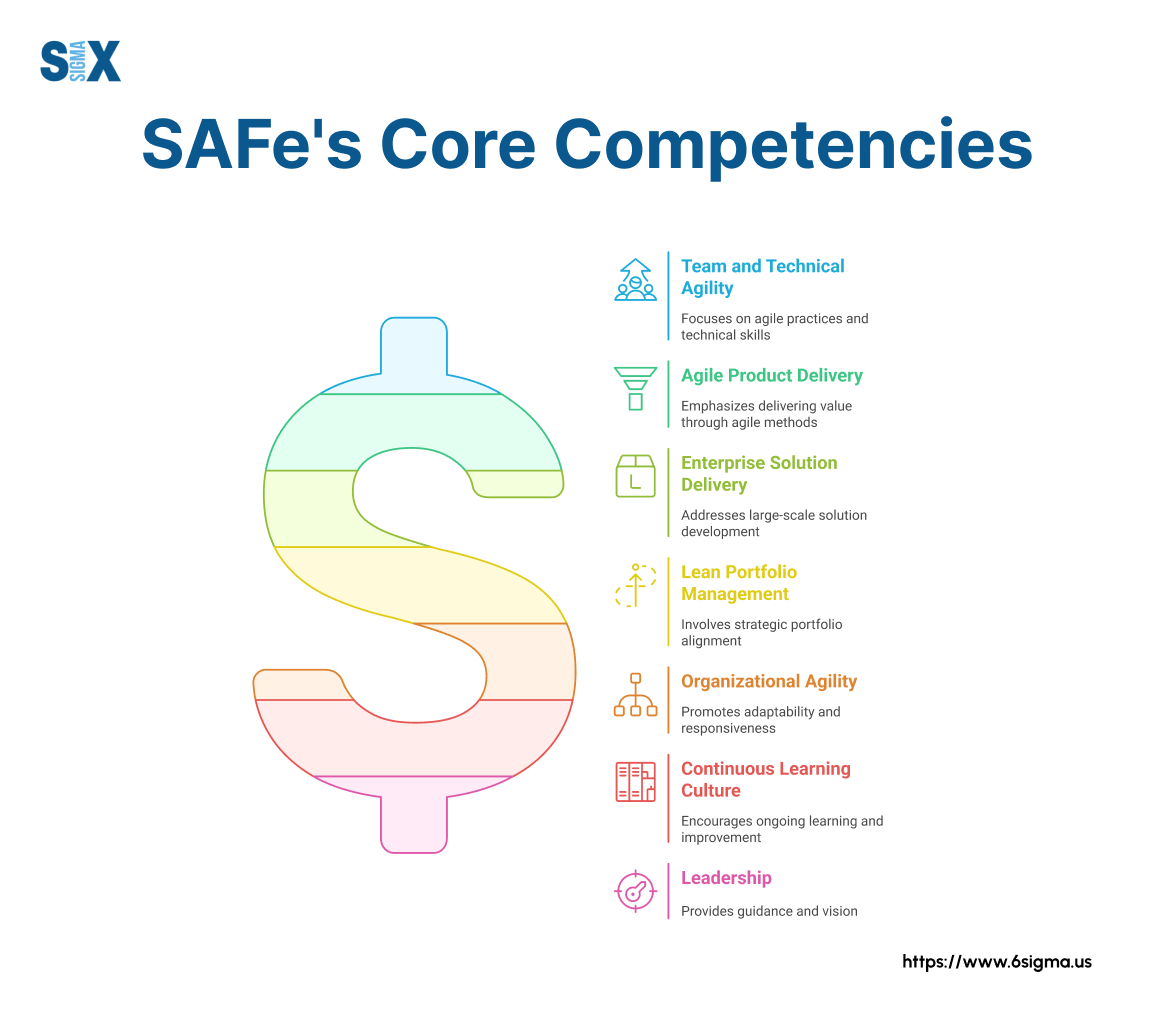
Key highlights
- Detailed breakdown of all competencies
- Implementation strategies for each competency
- Common challenges and practical solutions
- Measurement approaches for tracking progress
What Are SAFe Core Competencies: The Foundation
The competencies of SAFe represent measurable, observable patterns of knowledge, skills, and behaviors that enable organizations to achieve business agility.
Definition and purpose
Unlike simple practices or techniques, these SAFe core competencies function as integrated capability sets that organizations must develop and strengthen over time.
Each competency contains a set of related knowledge areas, skills, tools, and practices. Think of them as organizational muscles that grow stronger with consistent exercise and attention.
Just as physical fitness requires developing multiple muscle groups in harmony, business agility demands balanced growth across all seven competencies.
The SAFe core competencies work together as an interconnected system. An organization might excel in one or two areas but still struggle with overall agility if the remaining competencies remain underdeveloped.
Evolution in SAFe 6.0
SAFe 6.0 represents a significant evolution in how these competencies are structured and applied. Earlier versions of the framework emphasized practices and roles, while the current version places these competencies at the center of the model.
This shift reflects growing recognition that organizational transformation requires more than just implementing processes—it demands building fundamental capabilities.
The seven core competencies of SAFe now serve as the primary organizing principle for the entire framework.
Each competency contains specific practices, roles, activities, and metrics that guide implementation. This competency-based approach helps organizations focus on outcomes rather than just following prescribed steps.
The SAFe competencies share philosophical roots with lean introduction principles. Both approaches emphasize value delivery, waste reduction, and continuous improvement.
SAFe extends these concepts to address the unique challenges of software and systems development at scale.
The connection between SAFe core competencies and Lean-Six Sigma becomes particularly evident in areas like process improvement, variation reduction, and data-driven decision making.
Both methodologies seek to create predictable, high-quality outcomes through systematic approaches. SAFe adapts these principles to the unique challenges of complex product development.
The competencies of SAFe don’t exist in isolation—they interact and reinforce each other. Improvements in one area often catalyze progress in others.
Understanding these interactions helps organizations develop more effective transformation strategies.
Rather than treating each competency as a separate initiative, successful organizations look for synergies and reinforcing patterns. This systems thinking approach accelerates overall progress toward business agility.
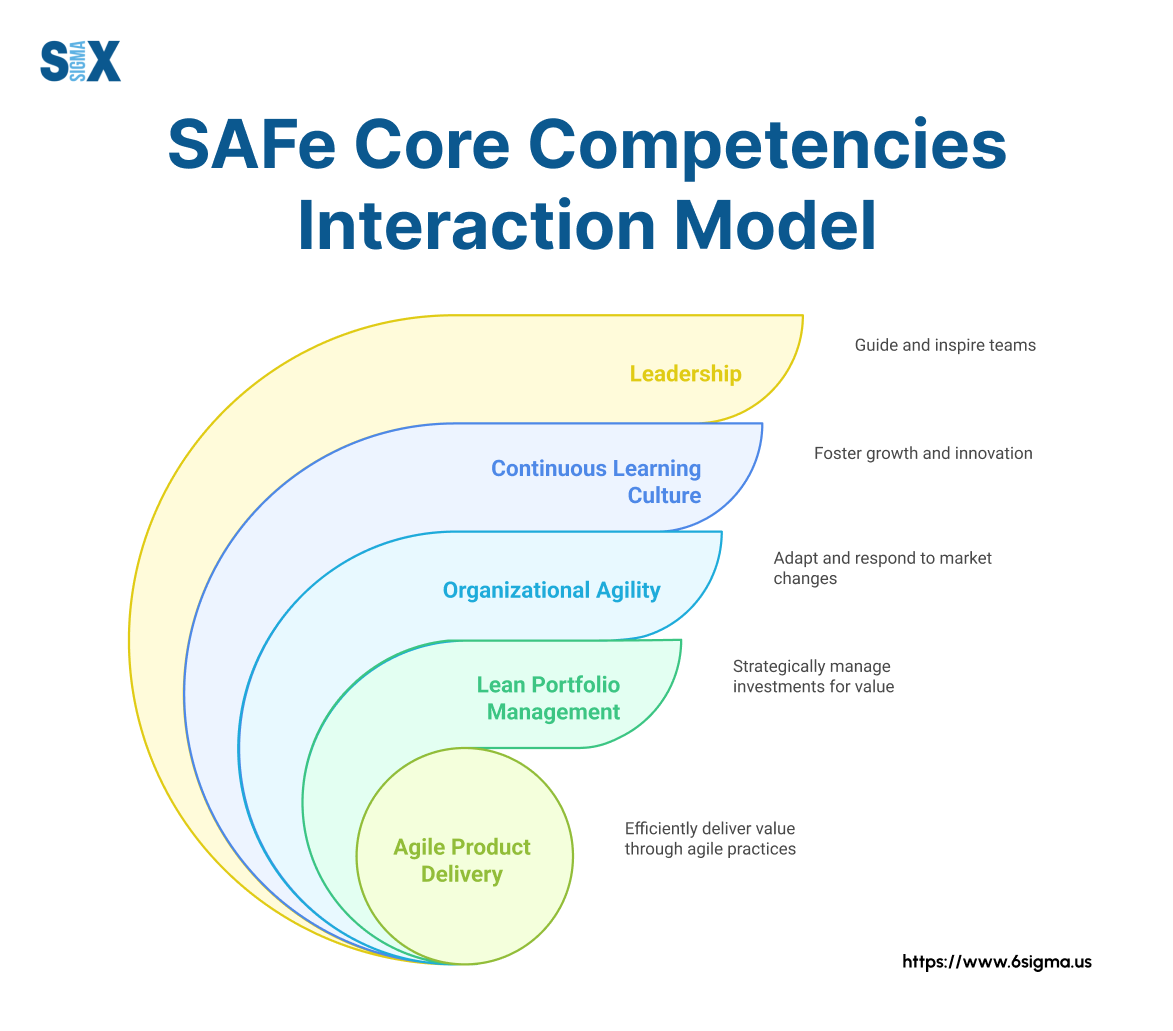
The Seven Core Competencies of SAFe Explained
The core competencies of SAFe agile provide the structural framework that enables organizations to achieve business agility.
Each competency addresses specific aspects of enterprise transformation, creating a holistic system that drives sustainable results.
Lean-Agile Leadership
Lean-Agile Leadership forms the foundation upon which all other competencies build. Leaders must first transform themselves before they can transform their organizations.
This means adopting new mindsets and behaviors that exemplify agile values and principles.
Effective Lean-Agile leaders model the change they expect to see. They demonstrate transparency, embrace uncertainty, and make decisions based on economic frameworks rather than political considerations.
These leaders understand that command-and-control approaches don’t work in complex environments where innovation and adaptation are essential.
Understand the core concepts of Lean Six Sigma methodology
Increase your professional marketability with Lean Six Sigma Overview course.
The leadership behaviors that drive successful SAFe implementations include:
- Leading by example through visible participation in agile events and practices
- Coaching others rather than dictating solutions
- Removing organizational impediments that block progress
- Creating environments where teams feel psychologically safe to experiment and learn
- Supporting decentralized decision-making while maintaining strategic alignment
This leadership approach shares many principles with Six Sigma certification methodologies, particularly in its emphasis on data-driven decision making and continuous improvement.
Both frameworks require leaders who can balance strategic vision with tactical execution while empowering teams to solve problems.
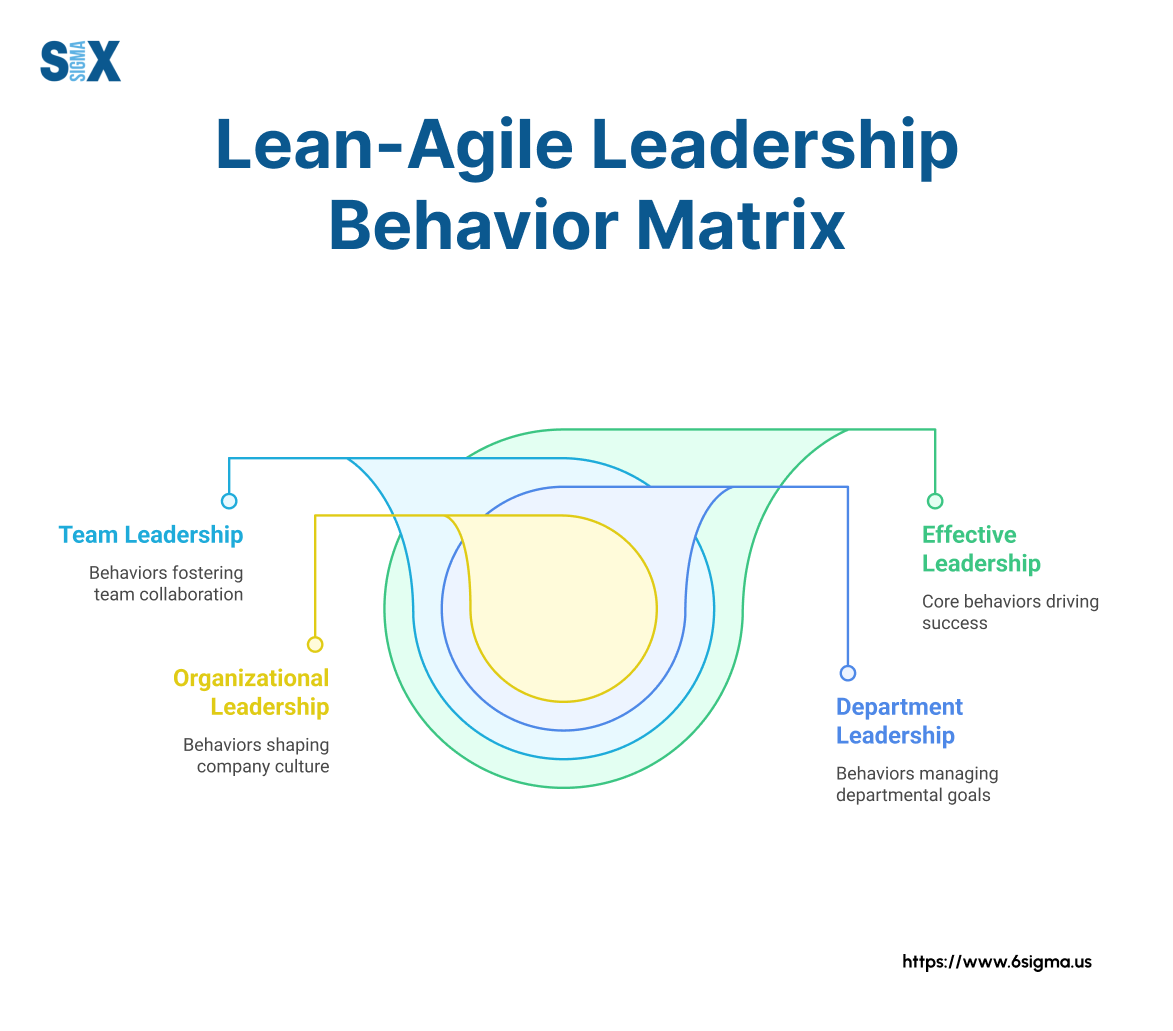
Team and Technical Agility
Team and Technical Agility focuses on the capabilities teams need to deliver high-quality solutions quickly and reliably.
This competency encompasses both the social aspects of teamwork and the technical practices that enable quality delivery.
High-performing agile teams demonstrate several key characteristics:
They self-organize around their work, taking collective ownership of outcomes rather than focusing on individual tasks.
They establish working agreements that guide their interactions and decision-making processes. They maintain a sustainable pace that balances productivity with long-term health.
The technical practices within this competency are equally important.
These include:
- Test-driven development that builds quality into the product from the start
- Continuous integration that prevents integration problems by merging code frequently
- Refactoring to maintain clean, maintainable code
- Architecture that evolves incrementally rather than being fully designed upfront
These technical practices align closely with quality management principles found in Six Sigma Black Belt certification programs.
Both approaches emphasize building quality into processes rather than inspecting it afterward, reducing variability, and creating predictable outcomes.
Agile Product Delivery
Agile Product Delivery represents the customer-focused approach to defining, building, and releasing products and services that deliver value continuously.
This competency brings together product management, user experience design, and engineering practices to create solutions customers actually want.
The customer-centric mindset forms the heart of this competency.
Teams develop deep empathy for users through techniques like:
- Customer interviews and observation
- User journey mapping
- Rapid prototyping and testing
- Continuous feedback loops
DevOps practices form another critical element of Agile Product Delivery.
Apply systematic problem-solving techniques
Improve product quality and customer satisfaction with Lean Six Sigma Green Belt Certification.

These practices break down traditional silos between development and operations, creating seamless flow from concept to cash.
Key DevOps capabilities include:
- Automated deployment pipelines
- Infrastructure as code
- Monitoring and observability
- Feature toggles and canary releases
Quality control in Agile Product Delivery relies heavily on automation and early feedback. Teams implement root cause analysis when issues occur, addressing systemic problems rather than just fixing symptoms.
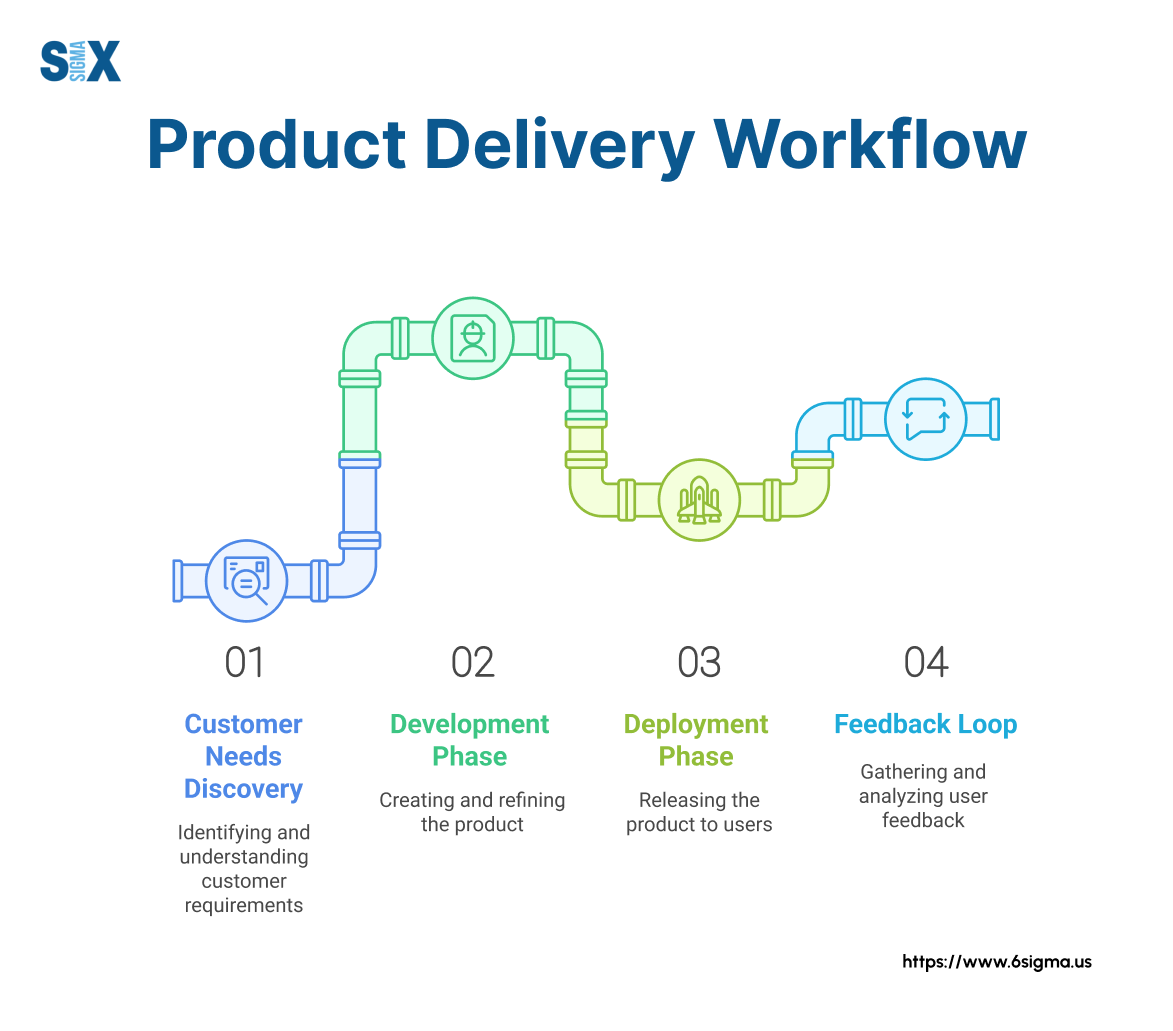
Enterprise Solution Delivery
Enterprise Solution Delivery addresses the challenges of building large, complex systems that require multiple teams working in coordination.
This competency enables organizations to apply agile practices at scale without sacrificing quality or predictability.
Scaling agile practices beyond the team level introduces new challenges.
Organizations must:
- Coordinate the work of multiple teams without creating excessive dependencies
- Maintain architectural integrity across a distributed development effort
- Ensure consistent quality standards and practices
- Align release schedules and integration points
Enterprise-level solutions often involve diverse technologies, platforms, and domains.
This complexity requires specialized approaches to:
- System architecture that balances local autonomy with global concerns
- Integration strategies that prevent late discovery of problems
- Verification and validation appropriate to the solution context
- Coordination mechanisms that minimize overhead while maintaining alignment
Cross-team coordination represents one of the most challenging aspects of this competency.
Techniques like Scrum of Scrums, Solution Train Engineers, and Communities of Practice help manage dependencies while preserving team autonomy.
Regular system demos ensure integration issues surface early when they’re cheaper to fix.
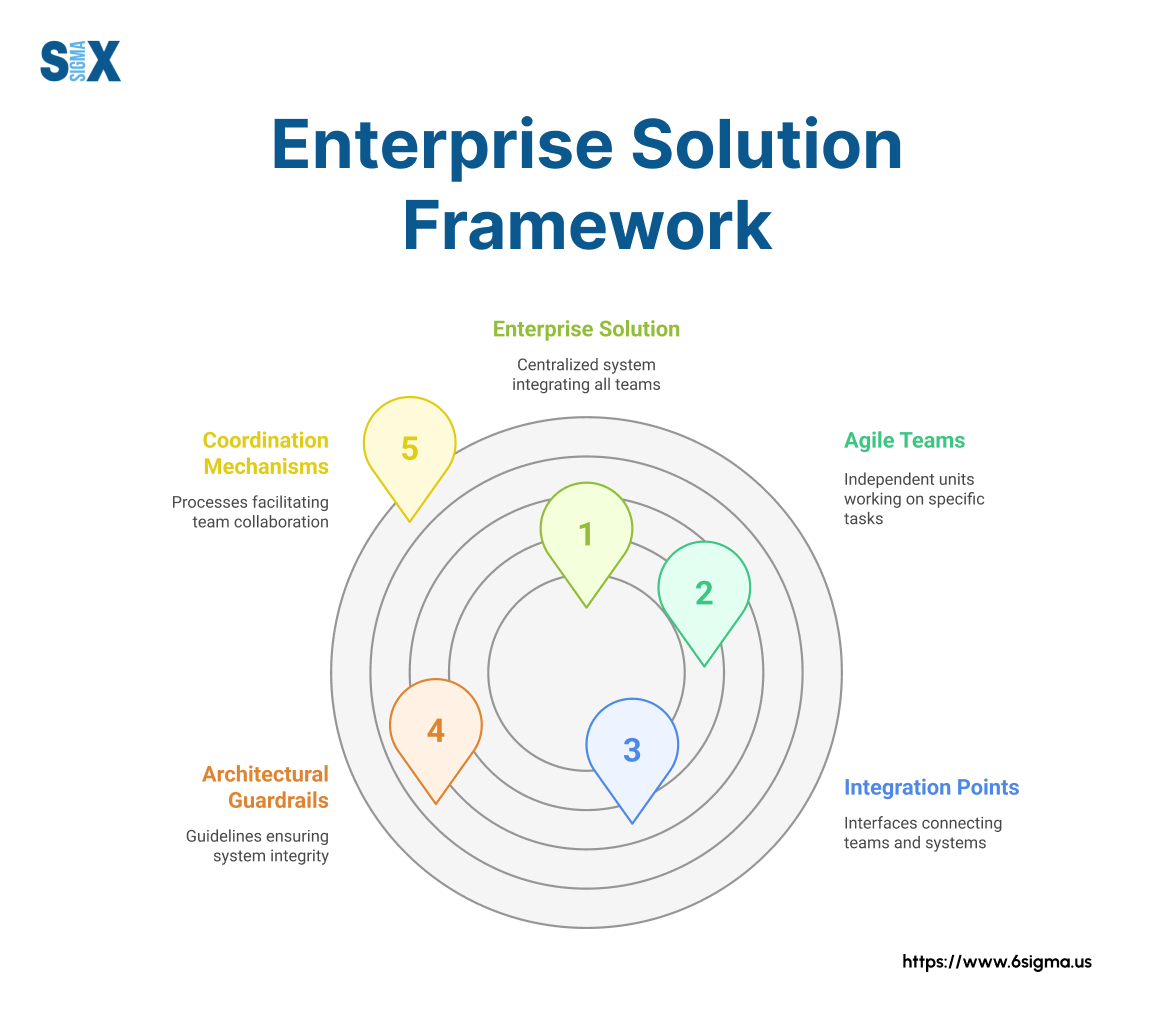
Lean Portfolio Management
Lean Portfolio Management aligns execution with strategy by applying lean and agile principles to portfolio management.
This competency transforms how organizations fund, prioritize, and govern technology investments.
Strategic alignment ensures technology investments support business objectives.
This requires:
- Clear articulation of strategic themes and business outcomes
- Translation of strategy into measurable objectives
- Portfolio vision that guides investment decisions
- Regular review and adjustment based on market feedback
Investment funding in Lean Portfolio Management shifts from project-based annual budgets to value stream-based dynamic funding.
This approach:
- Allocates resources to value streams rather than projects
- Empowers value streams to make local decisions about how to use funds
- Measures outcomes rather than outputs
- Adjusts funding based on demonstrated results
Portfolio operations provide the governance mechanisms needed to ensure compliance while enabling agility.
Key elements include:
- Lightweight business cases focused on outcomes
- Decentralized decision-making within guardrails
- Capacity allocation that balances innovation with maintenance
- Portfolio metrics that measure business value delivered
This approach to portfolio management connects directly to lean fundamentals, particularly in its focus on value streams, flow, and waste reduction.
Both methodologies seek to optimize the entire system rather than local efficiencies.
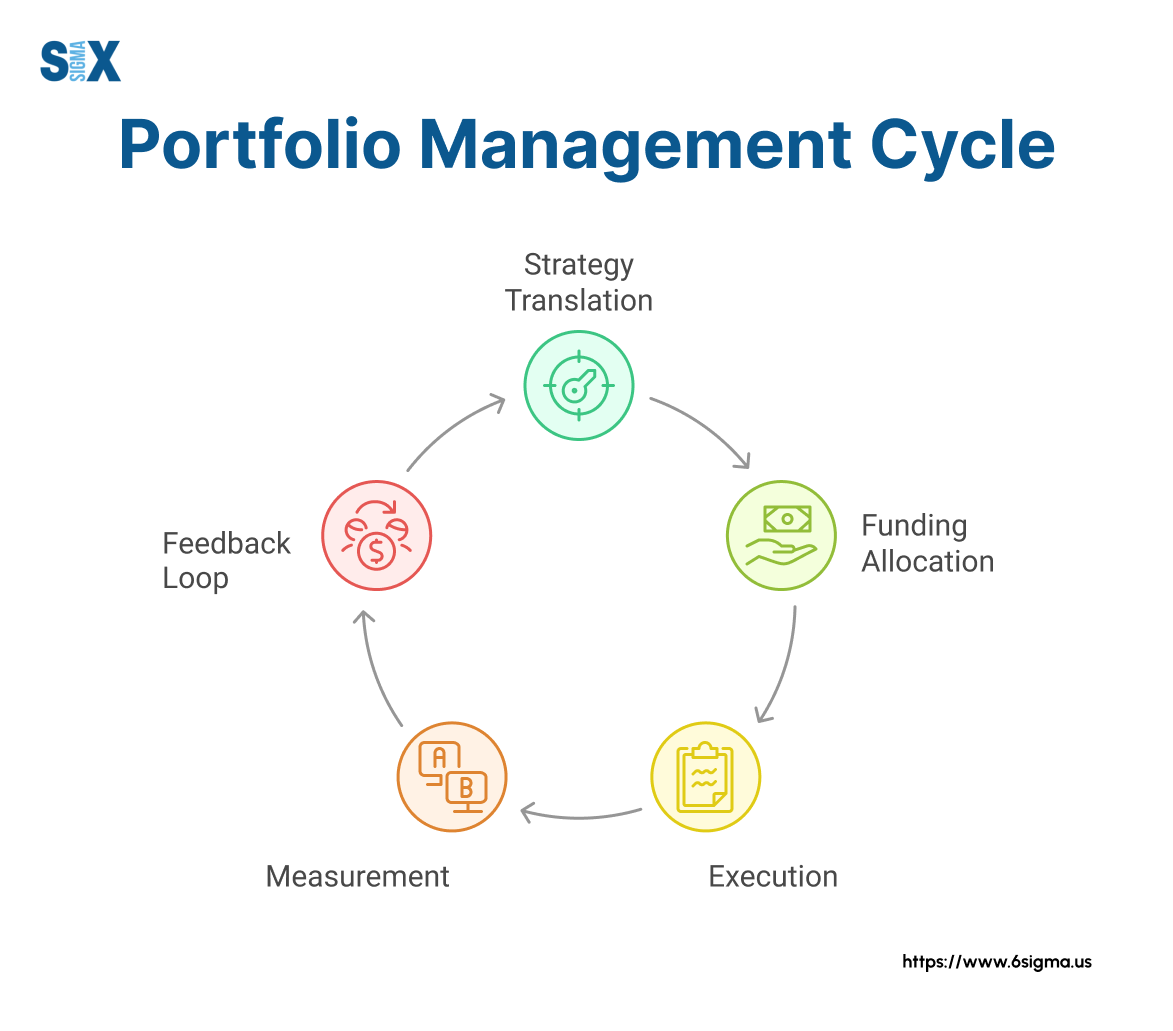
Organizational Agility
Organizational Agility extends agile thinking beyond technology teams to the entire enterprise.
This competency enables organizations to respond quickly to market changes and capitalize on emerging opportunities.
Lean business operations apply agile principles to all aspects of the business.
This includes:
- Visualizing work across departments to identify bottlenecks
- Implementing pull systems that respond to actual demand
- Reducing batch sizes to improve flow and feedback
- Eliminating handoffs and approvals that don’t add value
Strategy adaptation capabilities allow organizations to sense and respond to market changes.
Key elements include:
- Regular strategy review and adjustment cycles
- Decentralized intelligence gathering and analysis
- Hypothesis-driven approach to strategic initiatives
- Incremental implementation of strategic changes
Innovation culture provides the foundation for ongoing reinvention.
Organizations that excel in this competency:
- Allocate time and resources for exploration
- Create safe spaces for experimentation
- Celebrate learning from failures
- Rapidly incorporate successful innovations into mainstream operations
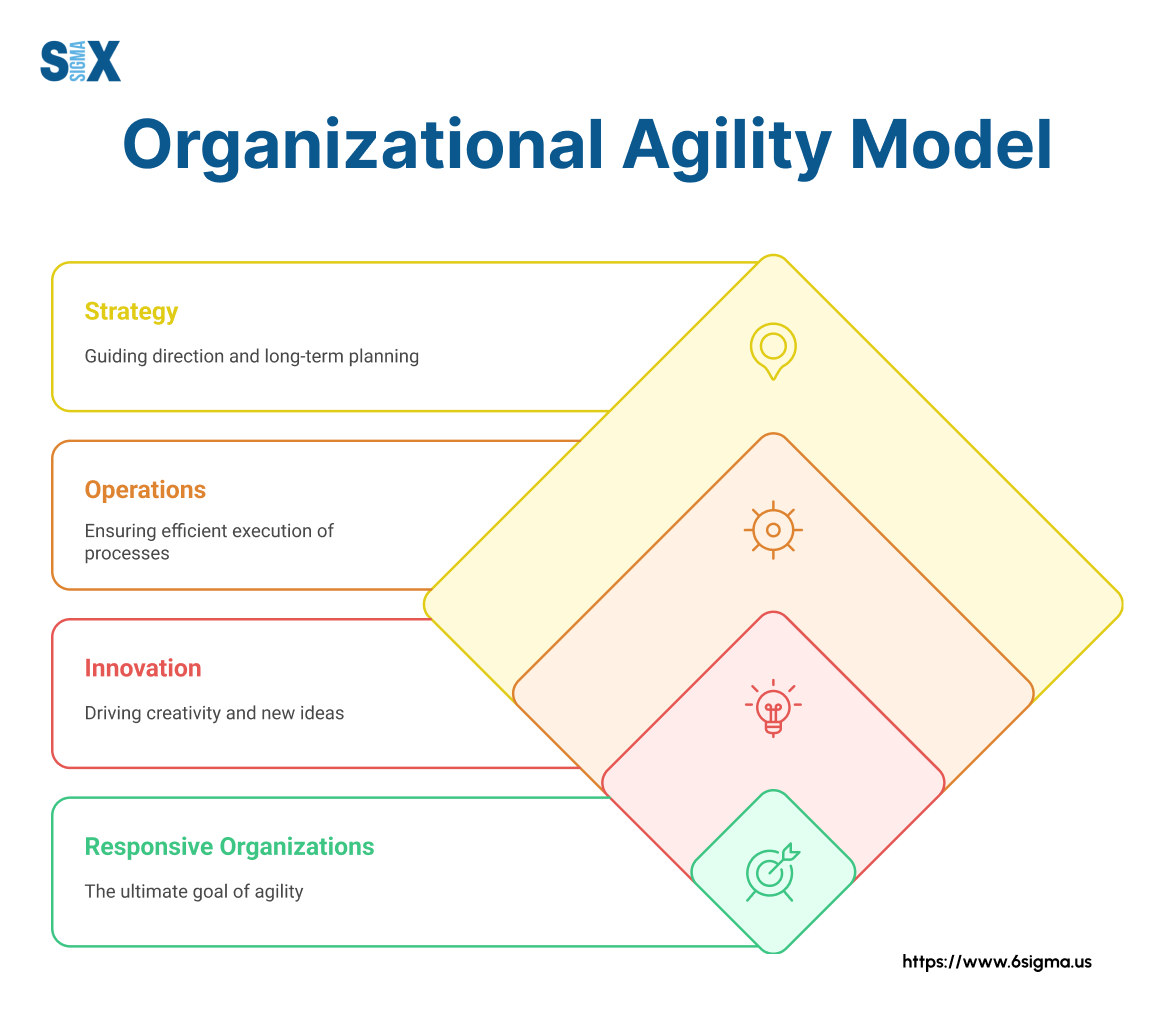
Continuous Learning Culture
Continuous Learning Culture creates an environment where learning is part of everyday work.
This competency enables organizations to improve constantly based on feedback, experimentation, and reflection.
The learning organization concept forms the foundation of this competency.
Key characteristics include:
- Knowledge sharing across organizational boundaries
- Time allocated for learning and improvement
- Leaders who model continuous learning behaviors
- Systems that capture and apply lessons learned
Innovation practices provide structured approaches to exploration and discovery.
These include:
- Innovation accounting that measures progress in uncertain domains
- Set-based design that explores multiple options simultaneously
- Minimum viable products that test hypotheses efficiently
- Innovation riptides that bring together diverse perspectives
Improvement cycles create regular cadences for reflection and adjustment.
Organizations implement:
- Retrospectives at multiple levels (team, program, portfolio)
- Improvement stories tracked alongside business features
- Metrics that measure both outcomes and capabilities
- Systematic approaches to experiment design and evaluation
The principles in this competency align closely with those found in Six Sigma Yellow Belt certification programs, particularly the emphasis on data-driven improvement and systematic problem-solving.
Both approaches create cultures where improvement becomes everybody’s responsibility.
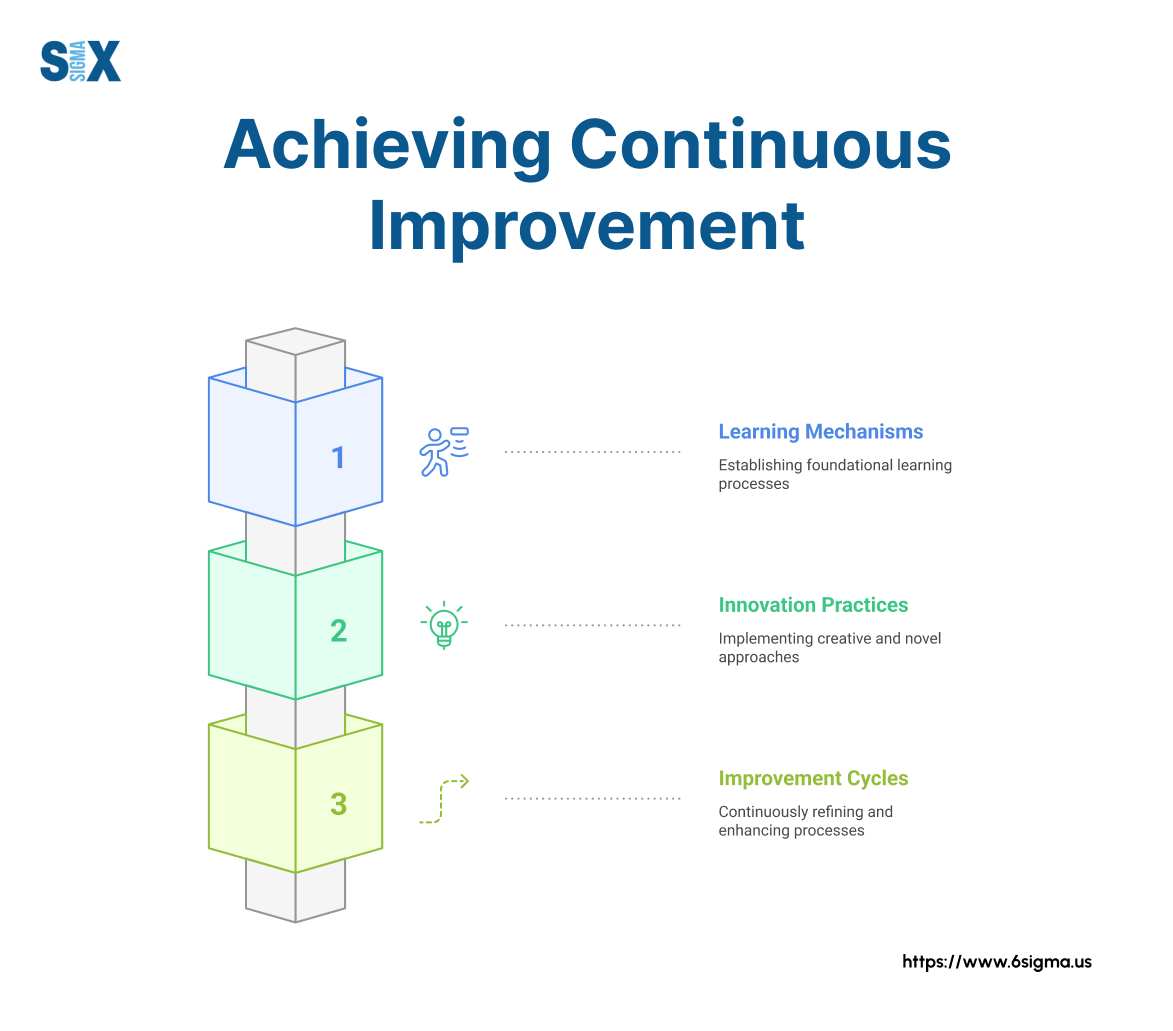
The seven competencies of SAFe work together as an integrated system.
The journey toward business agility requires sustained effort across all seven competencies, with each organization finding its own path based on its unique starting point and challenges.

Learn systematic approaches to organizational learning
Develop skills to drive innovation across your enterprise with Lean Six Sigma Yellow Belt Certification.
Implementing SAFe Competencies: Practical Approach
Moving from understanding the competencies of SAFe to actually implementing them requires a structured approach.
Organizations often struggle with the practical aspects of building these capabilities, particularly when faced with entrenched processes and resistance to change.
Assessment: Establishing Your Starting Point
Before embarking on any transformation journey, you need to know your starting point. A competency assessment provides this baseline understanding.
Effective assessment approaches for the SAFe competencies typically include:
Structured interviews with leaders, teams, and stakeholders to gather qualitative insights about current practices and pain points.
These conversations often reveal disconnects between what leaders think is happening and what teams experience daily.
Capability mapping workshops where cross-functional groups identify strengths and gaps across each competency.
These workshops build shared understanding while gathering valuable data.
Quantitative metrics that measure current performance in areas like delivery predictability, quality, time-to-market, and employee engagement. These metrics establish a baseline against which progress can be measured.
The SAFe implementation roadmap recommends using a simple maturity scale for each competency:
- Level 1: Initial – Basic practices performed inconsistently
- Level 2: Managed – Practices standardized but limited in scope
- Level 3: Defined – Practices consistently applied across the organization
- Level 4: Measured – Practices measured and controlled
- Level 5: Optimizing – Continuous improvement embedded
The assessment results should be visualized to create transparency and alignment. Heat maps showing competency levels across different business units often spark productive conversations about priorities and approaches.
Implementation: Building Capabilities Systematically
Implementing the competencies of SAFe requires a multi-faceted approach that addresses people, processes, and technology.
The SAFe implementation roadmap provides a proven sequence of steps:
- Reach the tipping point – Build a coalition of leaders committed to change
- Train change agents – Develop internal expertise to guide the transformation
- Train executives and managers – Ensure leadership understanding and alignment
- Create a lean-agile center of excellence – Establish transformation support structure
- Identify value streams and ARTs – Define the organizational structure for delivery
- Create implementation plan – Develop roadmap with measurable milestones
- Prepare for ART launch – Build readiness for initial implementation
- Train teams and launch ART – Begin the actual implementation
- Coach ART execution – Provide support during initial implementation
- Launch more ARTs and value streams – Expand the implementation
- Extend to the portfolio – Apply lean-agile principles to portfolio management
- Sustain and improve – Continuously enhance capabilities
This roadmap provides a logical sequence, but organizations should adapt it based on their specific context and assessment results. Some organizations may need to focus initially on leadership development, while others might prioritize technical practices or portfolio management.
The implementation approach should balance quick wins with sustainable change. Early successes build momentum and demonstrate value, while systematic capability building creates lasting transformation.
A common pattern includes:
- First 30 days: Leadership alignment and initial training
- First 90 days: Launch initial Agile Release Train (ART)
- First 180 days: Demonstrate measurable improvement in key metrics
- First year: Expand to multiple ARTs and begin portfolio transformation
Throughout implementation, regular assessment against the competency model provides visibility into progress and helps identify areas needing additional focus.
This creates a feedback loop that guides ongoing transformation efforts.
Integration: Connecting With Existing Practices
Few organizations implement SAFe in a greenfield environment. Most need to integrate the SAFe competencies with existing methodologies and practices.
This integration requires thoughtful planning to avoid creating parallel processes or conflicting guidance.
Many organizations already use quality improvement methodologies like Six Sigma Green Belt certification programs.
These approaches complement the SAFe competencies in several ways:
- Six Sigma’s emphasis on reducing variation aligns with SAFe’s focus on predictable delivery
- DMAIC problem-solving approaches enhance SAFe’s continuous improvement practices
- Data-driven decision making strengthens portfolio management and prioritization
- Process control techniques improve flow management in value streams
Other methodologies that often coexist with SAFe include:
- ITIL for service management – Can be integrated with DevOps practices in Agile Product Delivery
- Project Management frameworks – Can evolve toward Lean Portfolio Management approaches
- Enterprise Architecture – Can transition toward more adaptive models that support SAFe
The key to successful integration lies in focusing on outcomes rather than methodological purity. Organizations should identify the valuable elements from each approach and create a cohesive system that delivers business results.
Integration challenges typically include:
- Terminology conflicts between different frameworks
- Governance models that clash with agile principles
- Reporting requirements that drive non-agile behaviors
- Resource allocation models that hinder team stability
The implementation of SAFe competencies works best when approached as organizational development rather than process implementation.
Building these capabilities requires changes to mindsets, behaviors, structures, and systems – a true transformation rather than a simple process change.
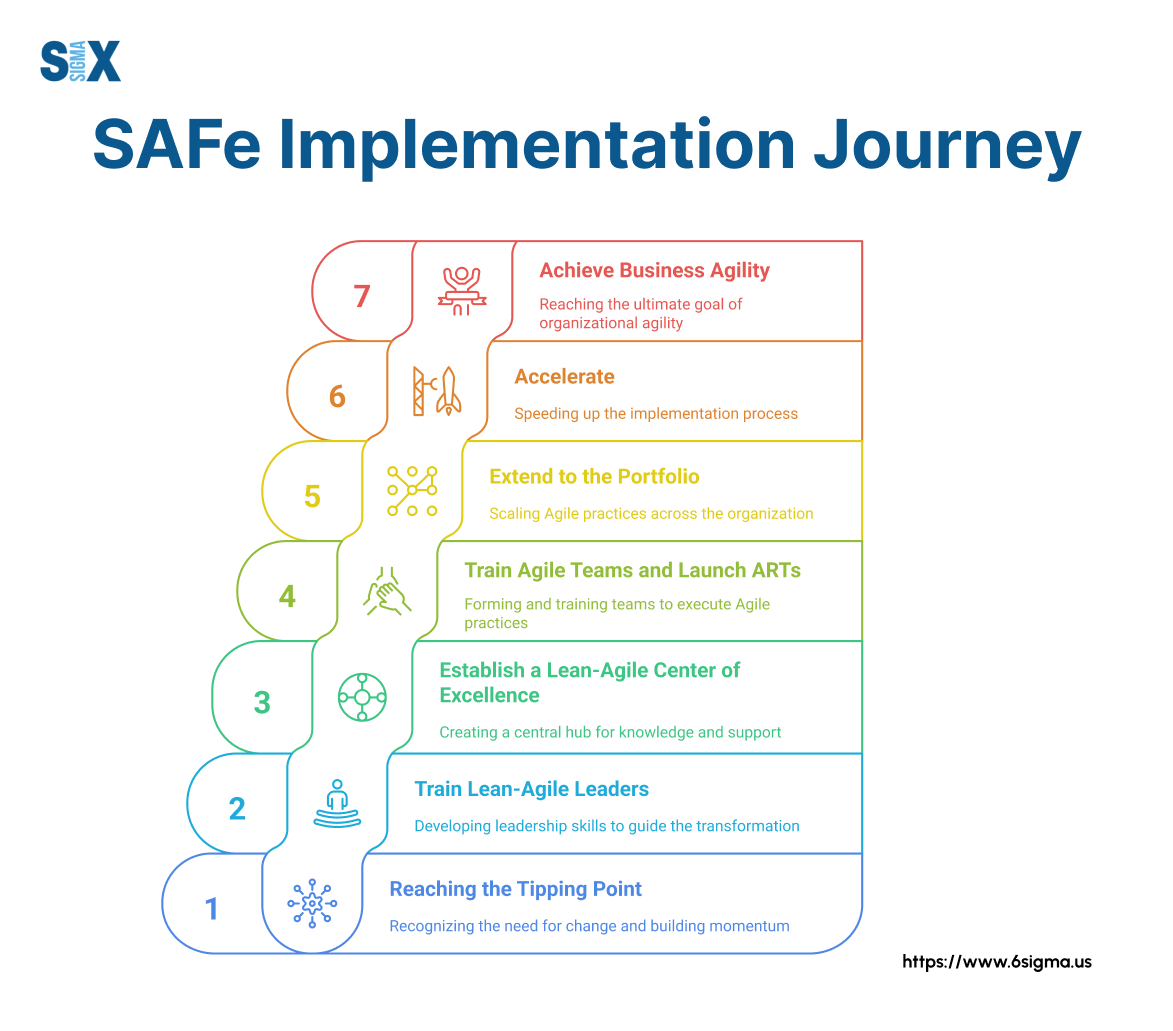
Common Challenges and Solutions with the Competencies of SAFe
Implementing the competencies of SAFe rarely follows a smooth, linear path. Organizations typically encounter various obstacles that can slow progress or derail transformation efforts entirely.
Understanding these common challenges—and proven strategies to overcome them—can significantly increase your chances of success.
Leadership Resistance and Misalignment
Perhaps the most significant challenge organizations face involves leadership buy-in and alignment.
When executives don’t fully understand or support the SAFe competencies, transformation efforts struggle to gain traction.
Signs of this challenge include leaders who continue to demand traditional project plans and Gantt charts while teams try to work in an agile manner.
Organizational Structure Misalignment
Traditional organizational structures often conflict with the value stream orientation required for SAFe competencies to flourish.
Functional silos, matrix management, and project-based funding models can severely hamper transformation efforts.
A healthcare technology company struggled with this challenge when attempting to implement the SAFe core competencies while maintaining strict functional departments.
Teams couldn’t align to value streams because people reported to functional managers who optimized for departmental efficiency rather than end-to-end flow.
Addressing this challenge requires thoughtful organizational design that balances functional excellence with value delivery.
Technical Debt and Legacy Systems
Many organizations struggle to implement the technical aspects of SAFe competencies due to significant technical debt and complex legacy systems.
This challenge particularly affects Team and Technical Agility and Agile Product Delivery competencies.
A retail company found that their teams couldn’t implement continuous integration practices because their monolithic legacy system made automated testing nearly impossible.
Every change required extensive manual regression testing, preventing the frequent releases needed for true agility.
Successful organizations tackle this challenge through incremental modernization approaches. Rather than attempting big-bang rewrites, they gradually improve architecture and technical practices while continuing to deliver business value.
Metrics and Incentive Misalignment
Traditional performance metrics and incentive systems often undermine the behaviors needed for SAFe competencies to develop.
When organizations reward individual heroics, utilization rates, or delivery against fixed scope and schedule, they create forces that work against agile transformation.
A government agency struggled with this challenge when they continued measuring success based on adherence to plans rather than value delivered.
Teams focused on completing predetermined scope rather than adapting to emerging needs, undermining the Organizational Agility competency.
Addressing this challenge requires thoughtful revision of metrics and incentives to align with desired outcomes.
Scaling Too Quickly
Many organizations attempt to implement all seven competencies of SAFe simultaneously across the entire enterprise. This big-bang approach typically leads to superficial adoption without meaningful capability development.
A manufacturing conglomerate faced this challenge when they mandated SAFe implementation across 15 business units simultaneously. The transformation team couldn’t provide adequate support, resulting in inconsistent practices and growing resistance.
Successful organizations take a more measured approach, focusing on building depth before breadth. They typically start with one or two value streams, develop true competency, and then expand based on lessons learned.
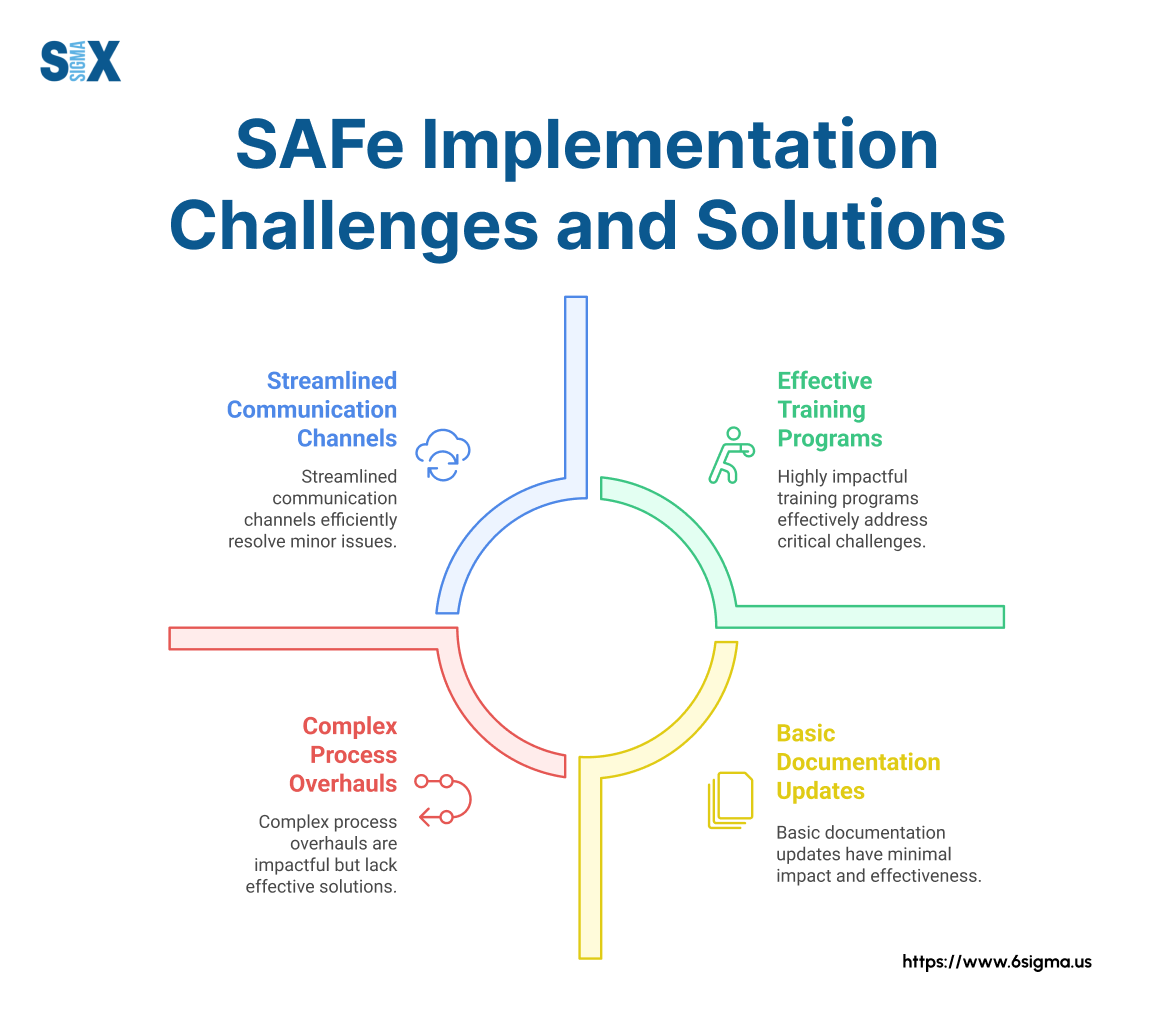
These challenges aren’t unique to any particular industry or organization size. Companies across sectors report similar obstacles when implementing the competencies of SAFe.
The differentiating factor lies not in avoiding these challenges but in how organizations respond to them.
Measuring Success and Continuous Improvement
Measuring progress in developing the competencies of SAFe provides essential feedback that guides improvement efforts.
Without clear metrics, organizations struggle to determine whether their transformation initiatives are yielding results or where adjustments might be needed.
Selecting The Right Metrics
The metrics used to track SAFe competencies should connect directly to business outcomes while providing insight into capability development.
Effective measurement systems typically include three types of metrics:
Business outcome metrics measure the ultimate results the organization seeks to achieve through greater agility.
These might include time-to-market, customer satisfaction, revenue growth, or market share. These metrics answer the fundamental question: “Are we getting better business results?“
Capability metrics assess the organization’s proficiency in each competency area.
These might include the percentage of teams using continuous integration, the frequency of portfolio adjustments, or the breadth of leadership participation in agile events. These metrics answer the question: “Are we getting better at the competencies?“
Activity metrics track the implementation of specific practices that contribute to competency development.
These might include the number of people trained, the frequency of retrospectives, or the percentage of work visualized on kanban boards. These metrics answer the question: “Are we doing the right things?“
For the competencies of SAFe, some particularly valuable metrics include:
For Lean-Agile Leadership: Leadership engagement score (measured through surveys), percentage of leaders participating in agile events, frequency of gemba walks
For Team and Technical Agility: Deployment frequency, lead time for changes, mean time to restore service, change failure rate (the “DORA metrics”)
For Agile Product Delivery: Cycle time from idea to production, feature usage metrics, customer satisfaction scores, percentage of features that deliver expected business outcomes
For Enterprise Solution Delivery: Integration frequency, cross-team dependency metrics, solution quality metrics, predictability of solution delivery
For Lean Portfolio Management: Portfolio cycle time, investment in each value category (e.g., maintenance vs. growth vs. transformation), innovation success rate, strategy alignment scores
For Organizational Agility: Time to pivot to new opportunities, cross-functional collaboration metrics, organizational impediment resolution time
For Continuous Learning Culture: Improvement story completion rate, innovation investment percentage, knowledge sharing activity metrics, experimental learning metrics
Tracking Progress Effectively
Once appropriate metrics are selected, organizations need effective systems to track progress over time. Transparency in measurement creates alignment and motivates improvement.
Visual management plays a crucial role in effective progress tracking.
Dashboards that display key metrics make progress visible to everyone in the organization. These dashboards should be accessible to all stakeholders and updated regularly to maintain relevance.
Regular assessment against the competency model provides another valuable tracking mechanism.
Trend analysis helps organizations understand whether they’re moving in the right direction. Rather than focusing solely on absolute numbers, effective tracking examines patterns over time.
Creating Effective Improvement Cycles
Measurement without action creates little value. Effective organizations establish regular improvement cycles that convert measurement insights into concrete changes.
These cycles follow the principles of lean fundamentals, creating a structured approach to continuous improvement.
The Inspect and Adapt (I&A) workshop represents SAFe’s primary mechanism for structured improvement.
Held at the end of each Program Increment, this workshop includes:
- A review of program increment objectives and metrics to assess what was accomplished
- A structured problem-solving workshop to identify improvement opportunities
- Creation of improvement stories that enter the backlog for the next program increment
This cadence-based approach ensures regular attention to improvement rather than treating it as a separate initiative.
By dedicating time specifically for reflection and adjustment, organizations make improvement part of their regular operating rhythm.
Beyond the formal I&A workshops, organizations should establish improvement mechanisms at multiple levels:
- Team-level daily standups and iteration retrospectives focus on immediate tactical improvements
- Program-level retrospectives address cross-team issues and coordination challenges
- Portfolio-level strategic reviews examine broader systemic issues and organizational impediments
Improvement communities create another powerful mechanism for advancing the competencies of SAFe.
Hackathons and innovation events provide focused time for exploring improvements to products, processes, or tools.
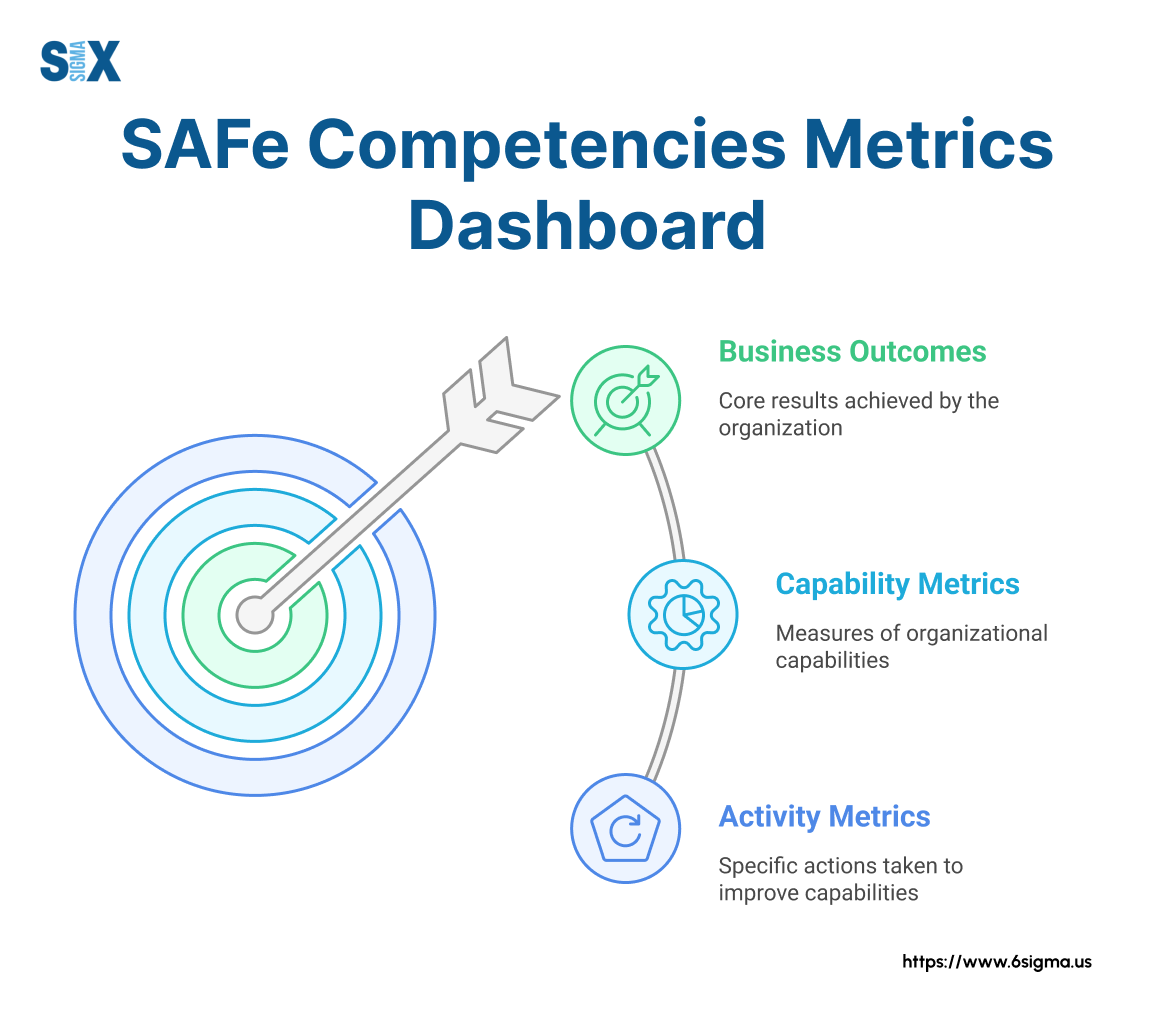
Conclusion
The seven core competencies of SAFe provide a structured framework for achieving business agility in complex enterprises.
Each competency addresses specific aspects of organizational capability, from leadership behaviors to technical practices to learning culture.
Together, they create a holistic system that enables organizations to deliver value quickly, adapt to changing conditions, and maintain competitive advantage.
Developing these competencies requires sustained effort and commitment.
Organizations must assess their current state, implement practices appropriate to their context, integrate with existing methodologies, overcome common challenges, and measure progress continuously.
The most successful implementations recognize that SAFe isn’t a rigid framework to be followed prescriptively.
SixSigma.us offers both Live Virtual classes as well as Online Self-Paced training. Most option includes access to the same great Master Black Belt instructors that teach our World Class in-person sessions. Sign-up today!
Virtual Classroom Training Programs Self-Paced Online Training Programs

